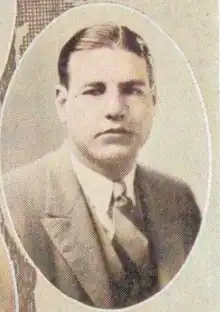Walter L. Voegtlin | |
|---|---|
 Voegtlin in 1926 | |
| Born | March 4, 1904 |
| Died | 1975 |
| Occupation(s) | Gastroenterologist, writer |
Walter Lyle Voegtlin (March 4, 1904 – 1975) was an American gastroenterologist and pioneer of the Paleolithic diet.
Biography
Voegtlin was born at Des Moines, Iowa.[1] He was educated at West Des Moines High School and Broadway High School.[1][2] He studied at the University of Washington (1926–1929) and Northwestern University Medical School (1929–1933).[1] He obtained his BA from Northwestern University in June, 1932.[1] Voegtlin's Master of Science thesis at Northwestern University was titled Evacuation of the Gall Bladder with Cholecystokinin as Studied by Duodenal Drainage.[3] He received his M.D. in 1935.[4]
In the 1930s, Voegtlin and psychiatrist Frederick Lemere at the Shadel Sanatorium (now Schick Shadel Hospital)[5] in Seattle promoted the use of aversion therapy to treat alcoholics.[6][7] Between 1936–1950 the facility treated over 5000 patients.[8] It has been described as the first successful treatment for alcoholism based on scientific principles.[9] In 1950, Voegtlin and Lemere reported that based on data from 4096 patients over 14 years there was a 60% abstinence at the 1-year point, 51% for two years, 38% for five years, and 23% for 10 years.[10][11]
The Stone Age Diet
Voegtlin was the first to publish a book The Stone Age Diet, based on the supposed principles of Paleolithic nutrition, in 1975.[12] The book has been cited as pioneering the Paleolithic diet.[12][13][14]
Voegtlin argued that humans are predominately carnivorous and should eat an animal-based diet of fat and protein with a minimum of carbohydrate. He stated that humans are anatomically closer to the carnivorous dog than the herbivorous sheep.[13] It was an eccentric book, in which Voegtlin advocated the mass slaughter of dolphins and tigers.[12] Food historian Adrienne Rose Johnson has commented that "Paleo leaders today have largely disavowed Voegtlin for his white supremacist, eugenicist, and generally unpalatable politics."[12] Sylvia R. Karasua, a Clinical Professor of Psychiatry has noted that "Voegtlin believed humans were “strictly carnivorous” until 10,000 years ago, something we now know to be patently false."[14]
Voegtlin emphasized the importance of meat in the diet with a very low percentage of carbohydrates and no raw vegetables.[14] Voegtlin who promoted an early version of the Paleo diet did not oppose consumption of all dairy products and legumes.[15][16] In an appendix to the book, Voegtlin promoted a low-carbohydrate diet consisting of meat, eggs, fish, cooked fruits and vegetables, green beans, cheese and sour cream.[15]
Personal life
Voegtlin married his wife Elene in 1932. Elene C. Voegtlin (1907–1962), died age 54.[17]
Voegtlin was in the US Navy and was on board the USS Missouri in Tokyo Bay during the Japanese Instrument of Surrender on September 2, 1945.[4]
He was a medical officer at the hospital on Pearl Harbor.[18] A flag from the USS Arizona was given to Voegtlin by a wounded seaman. Voegtlin gave it to his son Karl F. Voegtlin and it was donated to the Naval Station Everett.[18]
His son Karl F. Voegtlin is also a gastroenterologist.[4]
Selected publications
- Voegtlin, W., & Lemere, F. (1942). The Treatment of Alcohol Addiction: A Review of the Literature. Quarterly Journal of Studies on Alcohol 2: 717-803.
- Voegtlin, W., & Lemere, F. (1950). An Evaluation of the Aversion Treatment of Alcoholism. Quarterly Journal of Studies on Alcohol 11: 199-204.
- The Stone Age Diet: Based on In-Depth Studies of Human Ecology and the Diet of Man (Vantage Press, 1975)
See also
References
- 1 2 3 4 Voegtlin, Walter L. (1933). Evacuation of the Gall Bladder with Cholecystokinin as Studied by Duodenal Drainage. NorthWestern University, Department of Physiology and Pharmacology. p. 27
- ↑ Broadway Sealth 1926. Students of Broadway High School. Seattle: Washington. p. 58
- ↑ Master of Science With Titles of Theses. Northwestern University, 1934. p. 31
- 1 2 3 "1960 Alumnus Shares His Remembrances of Pearl Harbor". Northwestern Medicine Medical Alumni Association. June 2020, Issue 38. Retrieved April 10, 2021.
- ↑ "History of Schick Shadel Hospital" (PDF).
- ↑ Bellack, Alan S; Hersen, Michel; Kazdin, Alan E. (1985). International Handbook of Behavior Modification and Therapy. Plenum Press. pp. 20-21. ISBN 978-1-4615-7280-0
- ↑ White, William L. (1998). Slaying the Dragon: The History of Addiction Treatment and Recovery in America. Chestnut Health Systems. p. 106. ISBN 978-0938475071
- ↑ Miller, Peter Michael. (1976). Behavioral Treatment of Alcoholism. Pergamon Press. p. 76.
- ↑ Blum, Kenneth. (1991). Alcohol and the Addictive Brain. The Free Press. p. 51. ISBN 0-02-903701-8
- ↑ Jones, Marshall R. (1968). Aversive Stimulation. University of Miami Press. p. 15
- ↑ Reilly, Steve; Schachtman, Todd R. (2009). Conditioned Taste Aversion: Neural and Behavioral Processes. Oxford University Press. p. 452. ISBN 978-0-19-532658-1
- 1 2 3 4 Johnson, Adrienne Rose (2015). "The Paleo Diet and the American Weight Loss Utopia, 1975–2014". Utopian Studies. 26 (1): 101–124. doi:10.5325/utopianstudies.26.1.0101. S2CID 144735157.
- 1 2 Beals, Katherine (2016). "Pondering Paleo: Is a Paleolithic Diet the Key to Achieving Optimal Health and Athletic Performance?". ACSM's Health & Fitness Journal. 20 (6): 18–25. doi:10.1249/FIT.0000000000000253. S2CID 199266304.
- 1 2 3 Karasu, Sylvia R. (2016). "In Nutrition, Where Does Science Stop and Fantasy Begin?". Psychology Today. Retrieved April 10, 2021.
- 1 2 Voegtlin, Walter L. (1975). The Stone Age Diet. Vantage Press. pp. 259-263
- ↑ Huber, Hillary Fries (2013). "Beans, beans the magical fruit: Why the Paleo Diet should not exclude legumes". Popular Anthropology Magazine. 4 (2): 46–49.
- ↑ The Seattle Daily Times (January 24, 1962). p. 58.
- 1 2 Willadsen, Jeffry. (2012). "NSE commemorates Pearl Harbor". Kitsap Sun. Retrieved April 10, 2021.